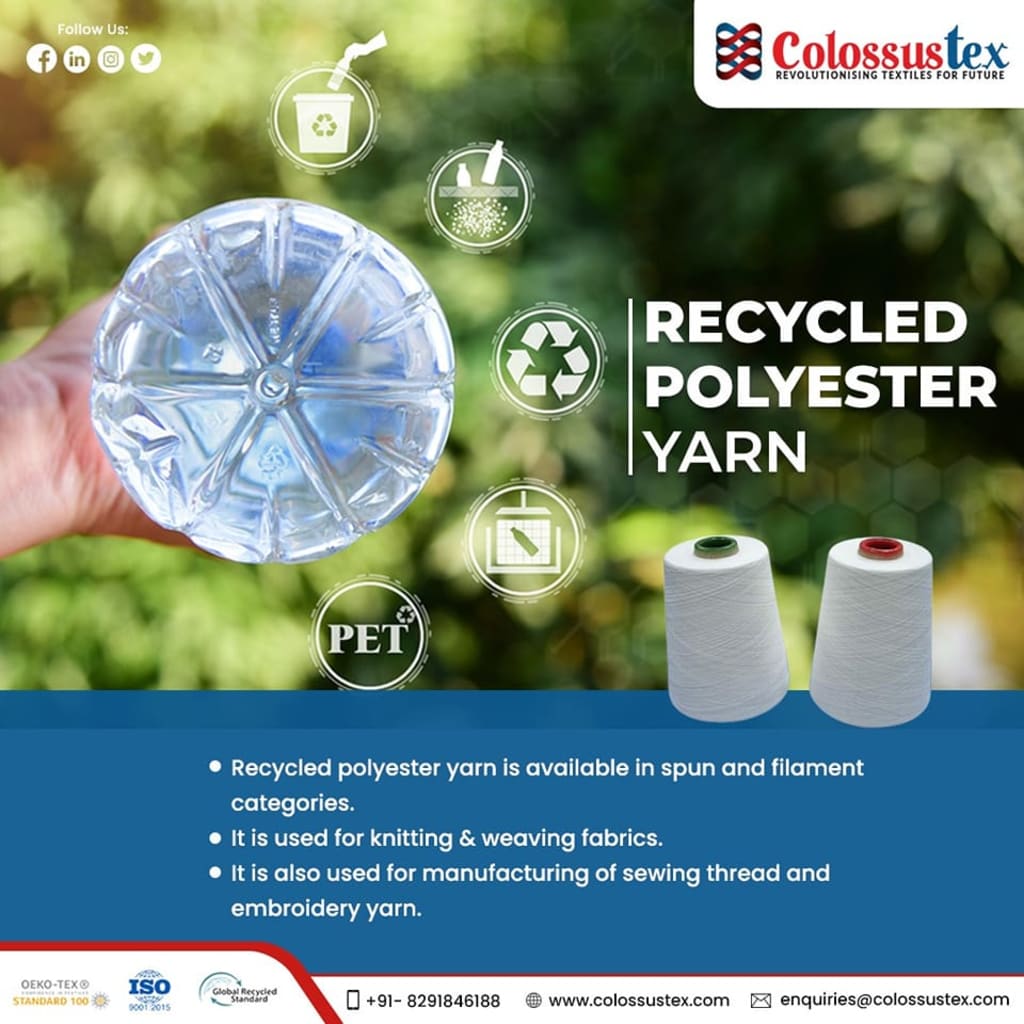Why the Recycled Polyester Yarns are Highly Effective?
Recycled Polyester arn

Recycled polyester yarn is nothing but melting down of plastics, and they are spun into threads that are stronger enough. These plastics are spun into the polyester fiber used for different types of materials. And this polyester is used in many industrial places and some post-consumer materials. Convert into the fine fiber and threats will be highly effective and efficient to use regularly.
Changing PET into recycled polyester utilizes less water and energy than it would deliver virgin polyester. Most examinations show that between 33-53% less energy is utilized to make recycled polyester versus virgin polyester. Moreover, fewer CO2 discharges are created, and we don't have to utilize non-inexhaustible assets. We process recycled polyester yarns by expelling recycled chips. The recycled yarns are provided to material and floor covering producers. It adds to decreasing our carbon impression by reusing PET-based items.
How the recycling processes are done?
Mechanical reusing is achieved by softening the plastic and expelling it to make yarns. Nonetheless, this must be completed not many times before the atomic construction separates and makes the yarn reasonable just for the landfill where it might never biodegrade, may biodegrade gradually, or may add hurtful materials to the climate as it separates like antimony. William McDonough refers to this as downcycling.
Substance reusing implies breaking the polymer into its atomic parts and transforming the particle into a yarn of equivalent strength and magnificence as the first. Unfortunately, the innovation to isolate the different compound structure blocks called depolymerization so they can be reassembled polymerization is absurd and practically nonexistent.
Most reusing is done precisely or, as indicated above, by real individuals. Compound reusing makes another plastic of a similar quality as the first, yet the cycle is over the top expensive. Even though Teijin has another program that reuses PET filaments into new PET strands, it is rarely done.
The genuine issue with making recycled Recycled polyester yarn a staple of the fiber business is this: reusing, as many people think about it, is a fantasy. Many people accept that plastics can be boundlessly recycled, making new results of worth to the old jugs or different plastics they obediently put into reusing compartments to be gathered. The cruel reality is that there is no such thing as reusing plastic since it's anything but a shut circle.
None of the pop and milk bottles gathered from your curbside are utilized to make new pop or milk bottles because each time the plastic is warmed, it degenerates, so the following emphasis of the polymer is corrupted and can't fulfill food quality guidelines for pop and milk bottles. The plastic should be utilized to make lower-quality items. The cycle resembles this: virgin PET can be made into pop or milk bottles, which are gathered and recycled into tars which are proper to make into toys, covers, filler for pads, CD cases, plastic timber items, filaments, or 1,000,000 different items.
These second-era plastics can then be recycled a second time into park seats, covers, hindrances, or different items with extremely low worth. The cycle is finished when the plastic is at this point not steady to the point of being utilized for any item, so it is shipped off the landfill where it is burned now and again for energy age, which a decent LCA will balance - or where it will hold space for a long time or perhaps become a piece of the Great Pacific Garbage Patch!
Furthermore, there is one more thought in reusing PET: antimony, which is available in 80 - 85% of all virgin PET, is changed over to antimony trioxide at high temperatures -. For example, they are essential during reusing, letting this cancer-causing agent out of the polymer and making it accessible for consumption in living frameworks.
Involving recycled PET for filaments likewise makes issues explicit to the material business:
The base shade of the recycled polyester chips differs from white to soft yellow, making shading consistency hard to accomplish, especially for the pale shades. A few dyers find it difficult to get a white, so they utilize chlorine-based blanches to brighten the base.
Irregularity of color take-up makes it challenging to get great group-to-clump shading consistency, and this can prompt high degrees of re-coloring, another exceptionally high energy process. But, again, Re-coloring adds to high degrees of water, energy, and substance use.
Unverified reports guarantee that a few recycled yarns take practically 30% more color to accomplish similar profundity of shade as identical virgin polyesters. One more thought is the presentation of PVC into the polymer from bottle names and coverings.
Conclusion:
The plastic is reusable, and with downgrade plastic, the threads are developed and provided for heavy industrial purposes. Numerous rPET filaments are utilized in excusing developments, for example, polar wool, where the development of the texture conceals slight yarn varieties. For textures, for example, glossy silks, there are worries over streaks and stripes.





Comments
There are no comments for this story
Be the first to respond and start the conversation.